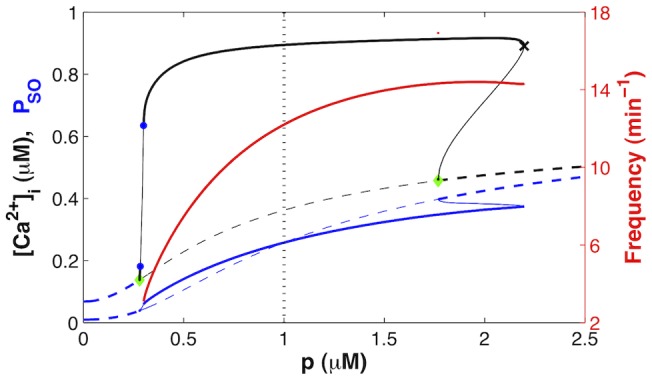Figure 4.
 dynamics as a function of agonist concentration.
dynamics as a function of agonist concentration.

Dashed curves represent steady-states (constant  levels); solid curves, periodic solutions (
levels); solid curves, periodic solutions ( oscillations). The maximum
oscillations). The maximum  (black) and the maximum fraction of open SOCC (blue) during one solution period are plotted as ordinates. The red curve (right y-axis) shows the frequency of the
(black) and the maximum fraction of open SOCC (blue) during one solution period are plotted as ordinates. The red curve (right y-axis) shows the frequency of the  oscillations on the main stable segment (from the upper blue dot to the black cross), which fits the experimental range in human [2]. The stable solutions are represented as thick lines and unstable solutions as thin lines. The green diamonds represent Hopf bifurcations, the black cross, a saddle-node bifurcation, and the blue dots, period-doubling points. Period-doubled branches are not shown because they extend only over a tiny range of
oscillations on the main stable segment (from the upper blue dot to the black cross), which fits the experimental range in human [2]. The stable solutions are represented as thick lines and unstable solutions as thin lines. The green diamonds represent Hopf bifurcations, the black cross, a saddle-node bifurcation, and the blue dots, period-doubling points. Period-doubled branches are not shown because they extend only over a tiny range of  values; moreover it is likely that the deterministic description of
values; moreover it is likely that the deterministic description of  oscillations fails at these low agonist concentrations (see Discussion). The vertical dotted line indicates the value of
oscillations fails at these low agonist concentrations (see Discussion). The vertical dotted line indicates the value of  used in Fig. 3 (Table 1).
used in Fig. 3 (Table 1).
